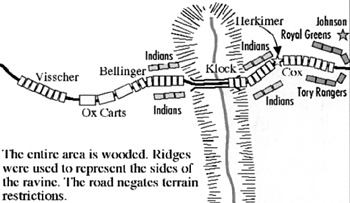The lead two American battalions were caught on the other side of Battle Creek whose only crossing point was at a wooded causeway. Further compounding the American problem was the fact that the rear regiment and ox carts were on the reverse slope of the ravine and couldn't actually see the lead units. One final aggravation was the narrowness of the road and the fact the ox carts blocked any line of retreat except for Visscher's rear guard militia unit.
The Royal Greens and Tory Rangers opened fire on the lead American units. The Indians on one side of the road could not resist charging the ox carts and rear guard so plowed into the American columns, causing serious confusion. Visscher's battalion, in true American militia fashion, immediately broke and ran, pursued by an unknown number of Indians.
After the first shock of fire, the remaining three American units eventually formed a ragged line, which as the battle progressed, transformed into separate knots of men arrayed in little circles to avoid rear charges by the Indians. Herkimer ordered his men to operate in twos, one firing, the other reloading; this was a tactic to prevent the Indians dashing in to tomahawk the militiamen while reloading. That little tactical innovation is one reason why Oriskany is hard to recreate at the battalion level.
 The entire area is wooded ridges were used to represent the
sides of the ravine. The road negates terrain restrictions.
The entire area is wooded ridges were used to represent the
sides of the ravine. The road negates terrain restrictions.
After an hour of fire and melee, all activity came to a halt while a fierce thunderstorm moved through the area. The thunderstorm lasted for about an hour and allowed the Americans to essentially regroup. This "natural" event doesn't really impact any simulation of the battle in miniature, therefore was left out. However, it might make a good play balance tool should the militia find it tough going in the early stages of the ambush to rally and form line or skirmish formations (in fact, the skirmish formation is probably the only way in PAL to generally simulate the "lots of little circles" formation adopted by the Americans during the first hour of the battle).
At about the same time the thunderstorm began to abate, a small detachment of Royal Greens came up the road with the coats turned inside out in an attempt to fool the Americans.
It worked at first but when some of the Americans recognized some of the Tories, general fighting began anew. W.J. Wood described the next hour of the battle as "the most savage fighting of the fiercest frontier battle of the war". It began to slacken when cannon shots were heard and word spread that a contingent of Continentals had sallied forth from the fort and were looting the Indian camp.
That was the final straw for the Indians who ha spent two hours fighting what was in essence, a fixed battle. The immediately began leaving, followed shortly by the two regular Tory units. The Continental sortie did not contact Herkimer's militia and while it contributed to Indian behavior at Oriskany, did not impact to the degree that makes it worth concocting special rule. Of course, it could be simulated in PAL by increasing or decreasing the percentage factor per permanent marker it takes to make the Indian force leave.
At best, Oriskany was a brutal draw for the Americans. No accurate loss estimates were ever totalled but American casualties probably numbered around 650 while the Tory/Indian forces lost only 150. Nonetheless, the Americans held the battlefield and did so by extricating themselves from a particularly bad situation. Furthermore, the losses inflicted on the Indians helped contribute to their general dissatisfaction with events which was exacerbated by Benedict's Arnold's ruse that convinced them 3,000 troops were 0 the way to relieve Ft. Stanwix.
When the Indians left, St. Leger had barely 1,000 troops, whereas Arnold had around 1900. St. Leger was forced to withdraw to Oswego and Burgoyne was left to his own designs. Oriskany set the stage for Arnold's relief operation, otherwise the Indian's might not have been so easy to convince to leave. Oriskany also showed that American militia could fight with its back to the wall, something that certainly was not lost on other officers fighting in the northern theater who would in turn apply those lessons learned in the south, namely Dan Morgan's use of militia at Cowpens.
More Oriskany
-
Battle of Oriskany: Introduction
Battle of Oriskany: Order of Battle and Rules
Battle of Oriskany: Historical Outcome
Back to Table of Contents -- Courier #77
To Courier List of Issues
To MagWeb Master Magazine List
© Copyright 1999 by The Courier Publishing Company.
This article appears in MagWeb (Magazine Web) on the Internet World Wide Web.
Other military history articles and gaming articles are available at http://www.magweb.com